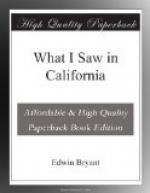over 300 or 400 miles of country, embracing all the
creeks and branches on the east side of the river Sacramento
and one side of the San Joaquin. In my travels
I have, when resting under a tree and grazing my horse,
seen pieces of pure gold taken from crevices of the
rocks or slate where we were stopping. On one
occasion, nooning or refreshing on the side of a stream
entirely unknown to diggers or ‘prospectors,’
or rather, if known not attended to, one of my companions,
while rolling in the sand, said, ’Give me a tin
pan; why should we not be cooking in gold sand?’
He took a pan, filled it with sand, washed it out,
and produced in five minutes two or three dollars’
worth of gold, merely saying, as he threw both pan
and gold on the sand, ‘I thought so.’
Perhaps it is fair that your readers should learn,
that, however plenty the Sacramento Valley may afford
gold, the obtaining of it has its disadvantages.
From the 1st of July to the 1st of October, more or
less, one half of the people will have fever and ague,
or intermittent fever. In the winter, it is too
cold to work in the water. Some work in the sand
by washing from the surface in a wooden bowl, or tin
pan; some gouge it out from the rocks or slate; the
more lazy ones roll about and pick up the large pieces,
leaving the small gold for the next emigration.
The extent of the gold region on the San Joaquin and
Sacramento rivers extends a distance of 800 miles
in length by 100 in width. It embraces not only
gold, but quantities of quicksilver in almost general
abundance. It is estimated that a small population
actively engaged in mining operations in that region
could export 100,000,000 dollars in gold in every
year, and that an increased population might increase
that amount to 300,000,000 dollars annually.
You may believe me when I say that for some time to
come California will export, yearly, nearly or quite
500,000 ounces of gold, 22 to 24 carats fine; some
pieces of that will weigh 16 lbs., very many 1 lb.
Many men who began last June to dig gold with a capital
of 50 dollars can now show 5000 to 15,000 dollars.
I saw a man to-day making purchases of dry goods,
etc., for his family, lay on the counter a bag
of raw hide, well sewed up, containing 109 ounces.
I observed, ’That is a good way to pack gold
dust.’ He very innocently replied, ’All
the bags I brought down are that way; I like the size!’
Five such bags in New York would bring nearly 10,000
dollars. This man left his family last August.
Three months’ digging and washing, producing
four or five bags, of 100 ounces each, is better than
being mate of a vessel at 40 dollars per month, as
the man formerly was. His companion, a Mexican,
who camped and worked with him, only had two or three
cow-hide bags of gold. In this tough, but true,
golden tale, you must not imagine that all men are
equally successful. There are some who have done
better, even to 4000 dollars in a month; many 1000
dollars during the summer; and others, who refused




